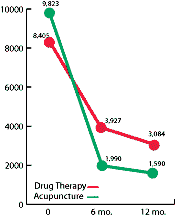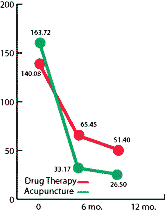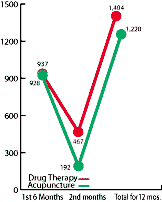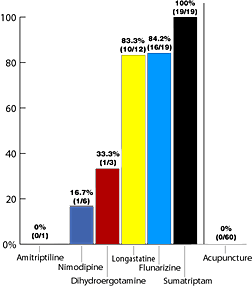Study Highlights the “Exceptional Usefulness” of Treatment
By Editorial Staff
Acupuncture Today
April, 2001, Vol. 02, Issue 04
According to the National Headache Foundation, as many as 28 million Americans suffer from migraine headaches each year.1 Migraines can be caused by a variety of physical and environmental factors, including diet, stress, allergens, menstruation, and changes in the weather.
They can last from a few minutes to several days, which in some cases may completely incapacitate the person suffering an attack.
 Figure I: Total migraine symptoms at baseline, six and 12 months after initial treatment.Migraine headaches are also one of the leading causes of time missed from work. It is estimated that migraine sufferers lose more than 157 million workdays each year, leading to a loss of approximately 50 billion dollars per year due to absenteeism and medical expenses caused by headache. An additional four billion dollars a year is spent on pain relievers for migraines and other headaches, but many of these remedies either do not work as needed, or simply mask an underlying condition.
Figure I: Total migraine symptoms at baseline, six and 12 months after initial treatment.Migraine headaches are also one of the leading causes of time missed from work. It is estimated that migraine sufferers lose more than 157 million workdays each year, leading to a loss of approximately 50 billion dollars per year due to absenteeism and medical expenses caused by headache. An additional four billion dollars a year is spent on pain relievers for migraines and other headaches, but many of these remedies either do not work as needed, or simply mask an underlying condition.
In one of the largest studies of its kind to date, a team of investigators in Italy examined the effectiveness of acupuncture versus a variety of pharmacological therapies in treating migraines. Their results, published in a recent issue of the Journal of Traditional Chinese Medicine,2 revealed that patients given acupuncture experienced fewer migraine episodes, missed fewer days from work, and suffered no side effects compared to patients on conventional drug therapy. They also found acupuncture to be more cost-efficient, estimating a savings of hundreds of millions of dollars in private and social health expenditures if it were used to treat headaches alone instead of drugs.
 Figure II: Average per-patient migraine values at baseline, six and 12 months after initial treatment.A total of 120 subjects with a history of migraine headaches (without aura) were divided into two treatment groups of 60 patients each. The first group was treated with acupuncture (a maximum of three courses of 10 treatments twice a week, with a one-week break between each course). Acupuncture needles were applied to five points — ST8; GB5; GB20; GV14; and LU7 — with practitioners using the reducing method.
Figure II: Average per-patient migraine values at baseline, six and 12 months after initial treatment.A total of 120 subjects with a history of migraine headaches (without aura) were divided into two treatment groups of 60 patients each. The first group was treated with acupuncture (a maximum of three courses of 10 treatments twice a week, with a one-week break between each course). Acupuncture needles were applied to five points — ST8; GB5; GB20; GV14; and LU7 — with practitioners using the reducing method.
The second group of patients received drug therapy consisting of two or three treatments using a variety of pharmaceutical products (flunarizine; nimodipine; dihydroergotamine; lisuride; sumatriptam; or amitriptiline). A subgroup of pharmaceutical patients received a drug called longastatine, along with electrical stimulation.
All patients received a 30-minute medical examination at the beginning of the study, with 15-minute examinations at intervals of three, six and 12 months. For the month prior to the start of care, and for 12 months following the first course of treatment, patients were also given a set of monthly time-sheets and asked to track several criteria, including the duration and severity of symptoms; general psychological and physical condition; side-effects; and work absences.
 Figure III: Total work absences at baseline, six and 12 months after initial treatment.To measure the daily impact of migraines, the researchers assigned values to the frequency, duration and severity of migraine symptoms. One unit of value was noted for each hour a patient had a migraine. If the migraine caused moderate pain, another unit was added; if the pain was intense, two units were added. Another unit was added if the migraine lowered the patient’s quality of life during that hour; two units were added if the patient became bedridden because of the condition. At the end of each month, the units were totaled and expressed as a negative number, indicating the extent to which a patient’s quality of life had been affected by migraine attacks.
Figure III: Total work absences at baseline, six and 12 months after initial treatment.To measure the daily impact of migraines, the researchers assigned values to the frequency, duration and severity of migraine symptoms. One unit of value was noted for each hour a patient had a migraine. If the migraine caused moderate pain, another unit was added; if the pain was intense, two units were added. Another unit was added if the migraine lowered the patient’s quality of life during that hour; two units were added if the patient became bedridden because of the condition. At the end of each month, the units were totaled and expressed as a negative number, indicating the extent to which a patient’s quality of life had been affected by migraine attacks.
Results
Statistical analysis of the groups found that acupuncture improved the symptoms of migraine without aura “more significantly” than any type of pharmacological therapy. Total symptom scores in the acupuncture group dropped more than 7,800 points from the start of study to six months after the first treatment; in comparison, scores in the drug therapy group dropped less than 4,500. Twelve months after the start of the study, total symptoms scores for patients using drug therapy were still nearly twice those compared to subjects treated with acupuncture (see Figure I).
 Figure IV: Side-effects experienced by drug therapy vs. acupuncture patients.These variations were also seen on an individual patient basis (see Figures II and III). Six months after receiving their first treatment, the average migraine value for a patient in the drug therapy group was 65.45, a reduction of nearly 46% from the start of care. For those in the acupuncture group, however, the results were even more dramatic: the average acupuncture patient’s migraine values decreased nearly 80%, from 163.72 at the start of the study to just 33.17 six months later. Acupuncture patients also experienced considerably fewer absences from work in the second six months of treatment compared to drug therapy patients.
Figure IV: Side-effects experienced by drug therapy vs. acupuncture patients.These variations were also seen on an individual patient basis (see Figures II and III). Six months after receiving their first treatment, the average migraine value for a patient in the drug therapy group was 65.45, a reduction of nearly 46% from the start of care. For those in the acupuncture group, however, the results were even more dramatic: the average acupuncture patient’s migraine values decreased nearly 80%, from 163.72 at the start of the study to just 33.17 six months later. Acupuncture patients also experienced considerably fewer absences from work in the second six months of treatment compared to drug therapy patients.
One of the most significant aspects of the study was that even though patients were asked to document any side-effects from treatment, none were reported by participants in the acupuncture group. According to the investigators, “no negative sign was highlighted” by subjects receiving acupuncture, leading to the conclusion that “the total absence of side-effects after acupuncture treatment can be affirmed.”
Patients in the drug therapy group did not appear to fare as well (see Figure IV). Of the 60 patients given pharmaceuticals, over three-quarters – 47 – reported side-effects ranging from nausea and diarrhea to flatulence and burning sensations. For instance, 16 of the 19 patients given flunarizine reported an unwanted weight gain of 3-4 kilograms; all 19 patients taking supatriptam, meanwhile, complained of difficulty breathing, nausea, stuffiness in the chest, and occasional vomiting.
In addition to patient values and pain scores, the researchers performed a cost-comparison of acupuncture and drug therapy, including the social costs for care (supported by the National Health Service); the cost to industry (due to absence from work); and the total private costs (paid by private citizens). The total costs for the acupuncture group were nearly 80 million lira less than expenditures for the drug therapy group (see Table I).
| Table I: Comparison of social, private and total costs for acupuncture and drug therapy groups. Social costs are obtained by adding the costs of the National Health Service to the total cost of absences from work. One U.S. dollar equaled approximately 1,632 Italian lira at the time of the study. | |||
| Type of cost | Period | Cost of acupuncture group (in lira) | Cost of drug therapy group (in lira) |
| National Health Service | First six months Second six months Year | Lit 288,721 Lit (-)829,524 Lit (-)540,803 |
Lit 24,197,404 Lit 393,340 Lit 24,590,744 |
| Absence from work | First six months Second six months Year | Lit 136,333,000 Lit 28,207,000 Lit 164,540,000 |
Lit 146,331,000 Lit 72,931,000 Lit 219,262,000 |
| Social costs | Year | Lit 163,999,197 | Lit 243,852,744 |
| Private costs | First six months Second six months Year | Lit 21,228,320 Lit 1,449,640 Lit 22,677,960 |
Lit 16,581,650 Lit 6,179,850 Lit 22,761,500 |
| Total | Year | Lit 186,677,157 | Lit 266,614,244 |
The researchers then extrapolated the information gleaned from the two groups and applied that data to the total number of patients in Italy affected by migraines without aura (approximately 800,000) to determine the costs if every migraine patient were treated with just acupuncture or just pharmaceuticals. The results were overwhelmingly positive for acupuncture, with an estimated cost savings of more than a trillion lira (approximately $653 million in U.S. currency at the time of the study) compared to drug therapy.
| Table II: Projected cost savings for migraine patients, acupuncture vs. drug therapy. | ||
| Costs | Acupuncture Group | Drug Therapy Group |
| National Health Service | Lit (-) 7,210,400,000 | Lit 327,876,800,000 |
| Absence from work | Lit 2,193,867,200,000 | Lit 2,923,493,600,000 |
| Total social cost | Lit 2,186,656,800,000 | Lit 3,251,370,400,000 |
| Private cost | Lit 302,372,800,000 | Lit 303,486,400,000 |
| Total cost | Lit 2,489,029,600,000 | Lit 3,554,856,800,000 |
| Projected total surplus | Lit 1,065,827,200,000 (appx. $653 million US) |
|
Analysis
While the value of acupuncture has gained a grudging acceptance by members of the medical community, few studies have examined the socioeconomic aspects of acupuncture compared to more “conventional” forms of care. The JTCM study addresses that issue while providing the groundwork for larger, more tightly controlled studies.
“Up to now, there has been neither precise data about these savings to the public, nor about the lack of risks for the patients treated with acupuncture for common diseases with a social cost,” the investigators noted in their conclusion. “Today, thanks to this study, we have precise data which prove the exceptional usefulness of acupuncture.”
The study also indicates that, contrary to those who would like to pigeonhole acupuncture into the realm of pain relief (and little else), it can do much more than just treat a painful condition. If research is conducted professionally and treatment is applied properly, acupuncture’s reach can extend beyond the walls of a clinic or pain center to have a positive effect on a nation’s social and financial well-being as well.
References
- NHF Headache Facts. Available from the National Headache Foundation (www.headaches.org).
- Liguori A, Petti F, Bangrazi A, Camaioni D, Guccione G, Pitari GM, Bianchi A, Nicoletti WE. Comparison of pharmacological treatment versus acupuncture treatment for migraine without aura – analysis of sociomedical parameters. J Tradit Chin Med 2000;20(3):231-40.